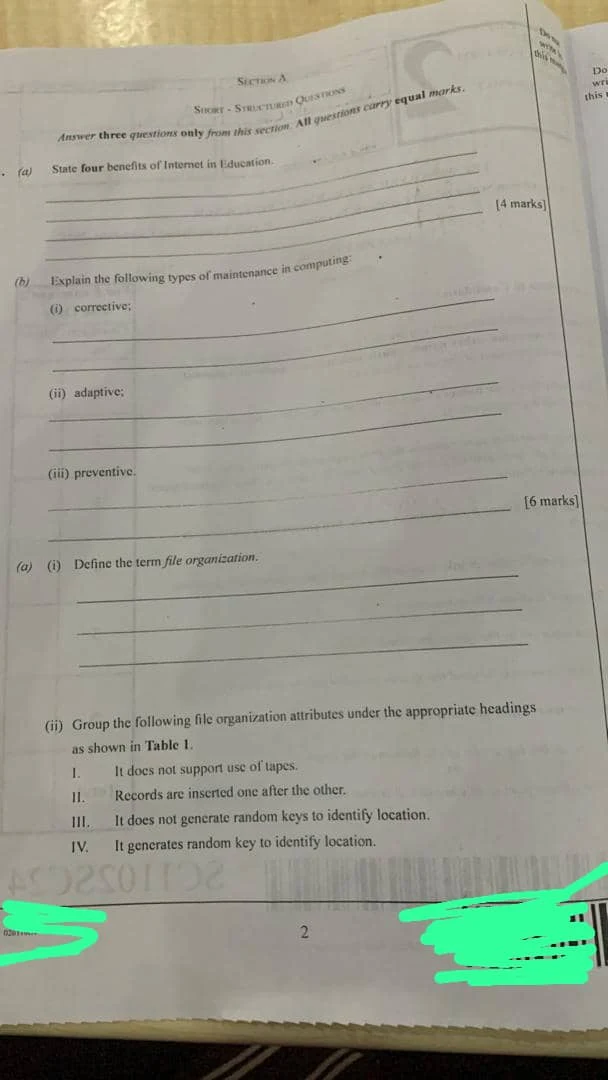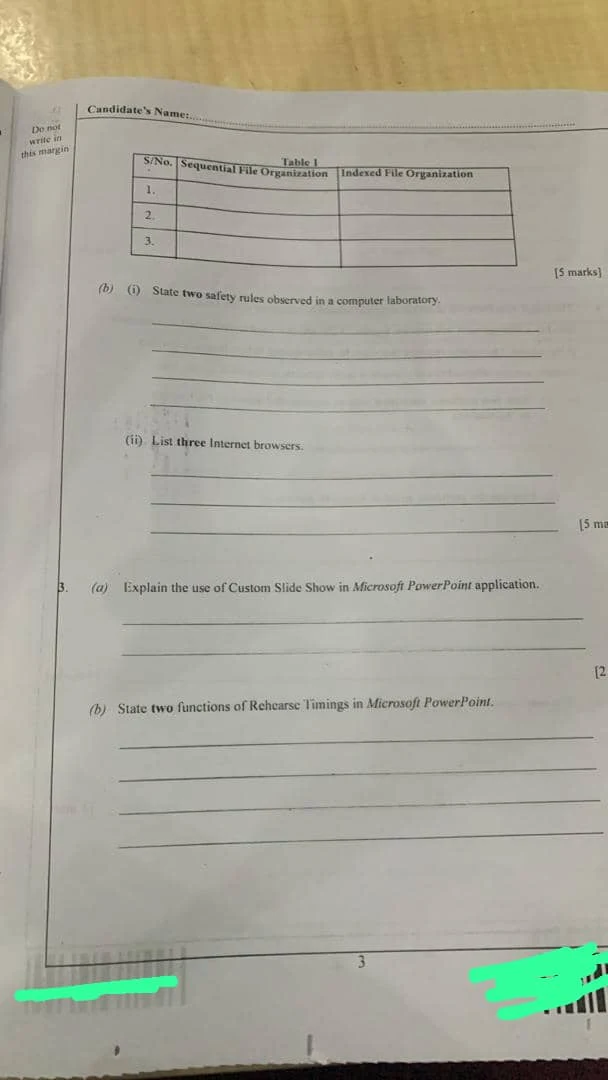Get 2024 WAEC Data Processing OBJ (Objectives) and ESSAY (Theory) Questions and Answers EXPO Room for School Candidate and Private Candidates. WAEC Data Processing OBJ and ESSAY Questions and Answers is now available, 2024 WAEC Free Question and Answer for Data Processing OBJ and Theory, 2024 WAEC syllabus for Data Processing free PDF download.

The West African Examinations Council (WAEC) has provided helpful materials on Data Processing to prepare you for the final exam, which will Start on Friday, 3rd May, 2024 , and will consist of Data Processing 2 (Essay) and Data Processing 1 (Objective). These materials will help you know what is expected of you and how to do your best in the Senior School Certificate Examination (SSCE).
WAEC Data Processing Question And Answer – Time/Date:
| Subject | Exam Type | Time | Duration |
|---|---|---|---|
2024 WAEC Data Processing (ESSAY) Answers:




WAEC 2024 Data Processing Answers
Question 1
(1a) Benefits of Data Processing in Education:
(i) Provides access to a vast amount of information for research and learning.
(ii) Facilitates communication and collaboration between students and teachers.
(iii) Offers online resources and tools for interactive learning experiences.
(iv) Allows flexibility in learning schedules and access to online courses and materials.
(1b) Types of Software Maintenance:
(i) Corrective Maintenance: Fixes errors or defects in software or hardware after they are detected through testing or user feedback.
(ii) Adaptive Maintenance: Modifies software or hardware to adapt to changes in the environment or new requirements.
(iii) Preventive Maintenance: Regularly updates and monitors software or hardware to prevent potential issues or failures.
Question 2
(2ai) File Organization:
File organization refers to how data is arranged and stored in a file system to allow efficient retrieval and storage of information.
(2aii) Types of File Organization:
- Sequential File Organization:
- Records are inserted one after the other.
- Direct (Random) File Organization:
- Uses random keys to identify the location of data.
- Indexed File Organization:
- Does not rely on the use of tapes.
- Hashed File Organization:
- Does not generate random keys to identify locations.
Question 5
(5a) Steps to Create a New Table in a Database:
(i) Click on the “Create” tab in the ribbon.
(ii) Click the “Table” button.
(iii) A new table will appear in the database window.
(iv) Add fields by clicking on the “Field Name” column and typing the field names.
(v) Set the data type for each field by selecting it in the “Data Type” column.
(vi) Repeat steps 4 and 5 for each required field.
(vii) Save the table by clicking on the “Save” button and entering a name.
(5b) Steps to Generate a Query:
(i) Click on the “Create” tab in the ribbon.
(ii) Select the “Query Design” button.
(iii) A query design window will open.
(iv) In the Show Table dialog, select the table(s) to include and click “Add”.
(v) Drag the required fields from the table(s) to the design grid.
(vi) Customize the query, such as adding criteria, sorting, or grouping.
(vii) Click “Run” to execute the query.
(viii) Save the query by clicking on “Save” and providing a name.
(5c) Steps to Create a Split Form:
(i) Click on the “Create” tab in the ribbon.
(ii) Select “Form” and choose “Split Form” from the dropdown.
(iii) In the Select Table or Query dialog, choose the data source for the form.
(iv) The split form will display with form and datasheet views side by side.
(v) Adjust the layout and design as needed.
(vi) Save the form by clicking “Save” and entering a name.
(5d) Steps to Print a Report:
(i) Click on the “Create” tab in the ribbon.
(ii) Select the “Report” button.
(iii) In the Select Table or Query dialog, choose the data source for the report.
(iv) The report will appear in the database window.
(v) Customize the report, such as adding headers, footers, and sorting.
(vi) Click “Print Preview” to review the report.
(vii) Click “Print” to print the report.
2024 WAEC Data Processing (Objective) Answers:
1-10: [Answers]
11-20: [Answers]
21-30: [Answers]
31-40: [Answers]
41-50: [Answers]
The answers and solutions provided are aimed at helping students prepare thoroughly for the WAEC 2024 Data Processing exam.
Click Here To Get Full Answers On WhatsApp
Recommended Post:
- 2024 WAEC Catering Craft Practice Questions and Answers | OBJ & ESSAY
- 2024 WAEC Mathematics May/June Questions and Answers (OBJ & Essay)
- 2024 WAEC Food and Nutrition (OBJ/ESSAY) Questions and Answers
- 2024 WAEC Literature OBJ (Prose, Drama & Poetry) Questions and Answers
- 2024 WAEC SSCE Timetable Out: Check Exam Dates Here
- WAEC May/June 2024 Tourism (ESSAY/OBJ) Questions and Answers
- 2024 WAEC Stenography (OBJ/ESSAY) Questions and Answers
- WAEC Biology (OBJ & ESSAY) Questions and Answers | 23rd May, 2024
- 2024 WAEC Civic Education (OBJ/ESSAY) Questions and Answers
- WAEC Commerce (OBJ/ESSAY) Questions and Answers | 11th June, 2024
- WAEC English (OBJ, Essay/Oral) Questions and Answers | 15th May, 2024
WAEC Data Processing Subscription Information:
| Subscription Type | Cost | Description |
|---|---|---|
| Direct Mobile Payment (Per Subject) | N800 | Get answers on time |
| Direct Mobile Payment (Per Practical) | N700 | Get answers on time |
How To Subscribe:
| Step | Action | Description |
|---|---|---|
| 1 | Buy MTN cards of N800 (400 + 400 = 800) | – |
| 2 | Go to your message, type the card pins correctly, and send to 09074969983 | – |
| 3 | Don’t call, just text; if the card pins are valid, a reply will be sent to you confirming your subscription | – |
| 4 | Relax and wait for your answers 30 minutes before the exam starts or after the exam starts | – |
Important Notes
- Do not send used card pins or your number will be blacklisted
- Keep refreshing this page for updates
Click Here to Join Our WhatsApp VIP Group.
DATA PROCESSING WAEC EXAMINATION SYLLABUS –2024
The 2024 WAEC Syllabus for Data Processing is available below. Please note that this syllabus applies to both school candidates and private candidates.
PREAMBLE
Important Note:
AIMS AND OBJECTIVES OF THE SYLLABUS
- Acquire basic skills of data processing and management
- Demonstrate competence in ICT applications that will promote the acquisition of entrepreneurial skills for everyday living in the global world
- Apply knowledge of ICT in facilitating business transactions and education
- Prepare for further studies in Data Processing and Management
The examination will consist of two papers, Papers 1 and 2, both of which shall be taken as a composite paper at one sitting.
- Consist of 40 multiple-choice objective questions
- All questions are to be answered in 1 hour
- Total marks: 40
- Consist of two sections: Sections A and B
- Candidates will be required to answer five questions in all
- Consist of four essay questions
- Candidates will be required to answer any three questions
- Time: 1 hour
- Total marks: 30
- Test of practical work
- Consist of two compulsory essay questions
- Time: 1 hour
- Total marks: 40
DETAILED SYLLABUS
| S/N | TOPICS | CONTENT | NOTES |
|---|---|---|---|
| 1 | Information Age | History of Computers | Identify various computing devices since the beginning of counting/computing. Relate each generation with its characteristic feature. Describe each generation under the following: year of development, basic component/type of technology, speed of operation, storage capacity/component. |
| Computing devices | i. Concept of Number system in computing | ||
| ii. Generations of Computer: first, second, third, fourth, fifth generations of computer | |||
| 2 | Data and Information | Definition of data and information | Emphasize differences between data and information |
| Types of Data | ii. Ways of handling Data | ||
| iii. Definition of Data | |||
| iv. Digitalization | |||
| 3 | Basic Computing | Classification of Computers | Classify computers by: Type, Size, Usage |
| 4 | Application of ICT | Uses of ICT in everyday activities | Link ICT application to societal development |
| Impact of ICT in the society | |||
| 5 | Components of Computers | Input Devices | Examples of each component should be treated and how they are used in data processing |
| Output Devices | |||
| System Unit | |||
| Storage Devices |
INFORMATION PROCESSING AND TRANSMISSION
| S/N | TOPICS | CONTENT | NOTES |
|---|---|---|---|
| 6 | Information Processing | Definition of Information Processing | Describe each step involved in information processing |
| Steps involved in Information Processing | |||
| 7 | Information Transmission | Definition of Information Transmission | Modes of information transmission such as visuals, audio, audiovisual are required |
| Methods of transmitting information | |||
| 8 | Medium of Information Transmission | Types of Information Transmission | Medium of information transmission such as radio, television, newspaper etc. |
| Classification of means of transmission | |||
| 9 | Networking | Meaning of Networking, Internet and Intranet | Significance of networking should be mentioned |
| Types of Networking | Types such as MAN, LAN, WAN should be treated | ||
| 10 | Internet | Definition of Internet | Benefits of internet, Internet browsers, Internet security, Abuse of the Internet |
| 11 | Tools for Processing Information | Operating System | Definition of Operating System, Types of Operating System, Examples of Operating System, Functions of Operating System |
| Differences between text (character) base interface and Graphical User Interface should be treated |
APPLICATION SOFTWARE
- Definition: Word processing is the use of computers to create, edit, and print documents.
- Uses: Creating documents, reports, letters, and other written materials.
- Examples of word processing software: Microsoft Word, Google Docs, LibreOffice.
- Starting, loading, and exiting word processing software.
- Creating, saving, and retrieving documents.
- Definition: A spreadsheet is a computer program that allows users to store, organize, and analyze data in a table format.
- Uses: Budgeting, accounting, data analysis, and chart creation.
- Examples of spreadsheet applications: Microsoft Excel, Google Sheets, LibreOffice Calc.
- Loading and exiting spreadsheets.
- Creating, saving, and retrieving spreadsheet files.
- Definition: A database management system (DBMS) is a software program that allows users to create, manage, and interact with databases.
- Uses: Storing, retrieving, and managing large amounts of data.
- Examples of database applications: Microsoft Access, MySQL, Oracle.
- Loading and exiting DBMS.
- Creating, saving, and retrieving database files.
- Definition: A presentation package is a software program that allows users to create and design slides for presentations.
- Uses: Creating presentations, slideshows, and reports.
- Examples: Microsoft PowerPoint, Google Slides, LibreOffice Impress.
- Loading and exiting presentation programs.
- Creating, saving, and retrieving presentation files.
- Definition: Web design packages are software programs that allow users to create and design websites.
- Uses: Creating websites, web pages, and online content.
- Components: HTML, CSS, JavaScript.
- Examples: Adobe Dreamweaver, Microsoft Expression Web.
- Definition: Graphic packages are software programs that allow users to create and edit graphics, images, and other visual content.
- Uses: Creating graphics, logos, images, and other visual content.
- Examples of graphic packages: CorelDraw, Adobe Photoshop, GIMP.
